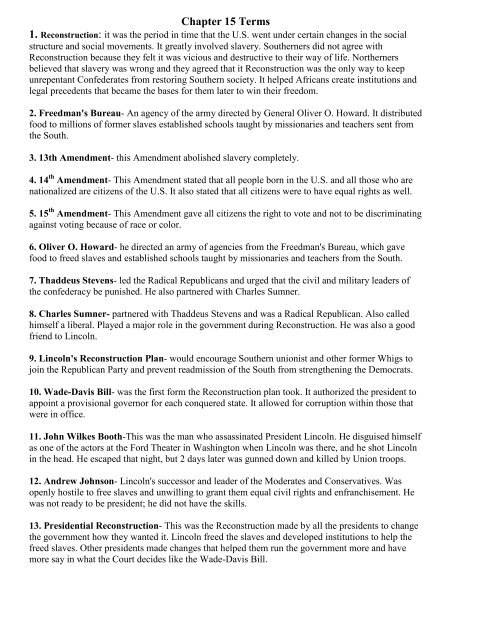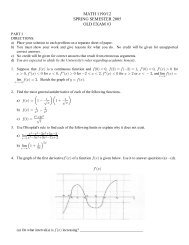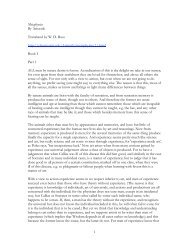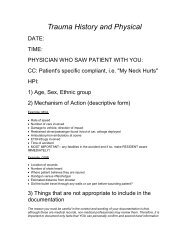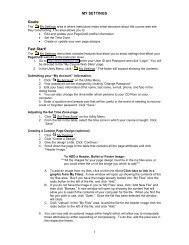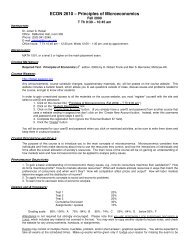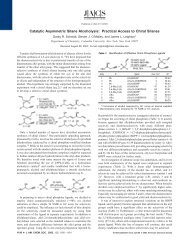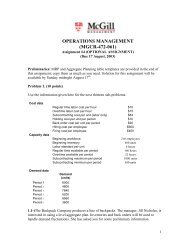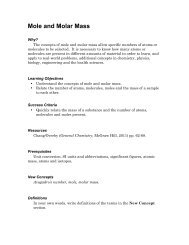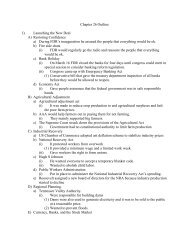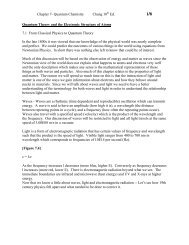Chapter 15 Terms - PageOut
Chapter 15 Terms - PageOut
Chapter 15 Terms - PageOut
Create successful ePaper yourself
Turn your PDF publications into a flip-book with our unique Google optimized e-Paper software.
<strong>Chapter</strong> <strong>15</strong> <strong>Terms</strong>1. Reconstruction: it was the period in time that the U.S. went under certain changes in the socialstructure and social movements. It greatly involved slavery. Southerners did not agree withReconstruction because they felt it was vicious and destructive to their way of life. Northernersbelieved that slavery was wrong and they agreed that it Reconstruction was the only way to keepunrepentant Confederates from restoring Southern society. It helped Africans create institutions andlegal precedents that became the bases for them later to win their freedom.2. Freedman's Bureau- An agency of the army directed by General Oliver O. Howard. It distributedfood to millions of former slaves established schools taught by missionaries and teachers sent fromthe South.3. 13th Amendment- this Amendment abolished slavery completely.4. 14 th Amendment- This Amendment stated that all people born in the U.S. and all those who arenationalized are citizens of the U.S. It also stated that all citizens were to have equal rights as well.5. <strong>15</strong> th Amendment- This Amendment gave all citizens the right to vote and not to be discriminatingagainst voting because of race or color.6. Oliver O. Howard- he directed an army of agencies from the Freedman's Bureau, which gavefood to freed slaves and established schools taught by missionaries and teachers from the South.7. Thaddeus Stevens- led the Radical Republicans and urged that the civil and military leaders ofthe confederacy be punished. He also partnered with Charles Sumner.8. Charles Sumner- partnered with Thaddeus Stevens and was a Radical Republican. Also calledhimself a liberal. Played a major role in the government during Reconstruction. He was also a goodfriend to Lincoln.9. Lincoln's Reconstruction Plan- would encourage Southern unionist and other former Whigs tojoin the Republican Party and prevent readmission of the South from strengthening the Democrats.10. Wade-Davis Bill- was the first form the Reconstruction plan took. It authorized the president toappoint a provisional governor for each conquered state. It allowed for corruption within those thatwere in office.11. John Wilkes Booth-This was the man who assassinated President Lincoln. He disguised himselfas one of the actors at the Ford Theater in Washington when Lincoln was there, and he shot Lincolnin the head. He escaped that night, but 2 days later was gunned down and killed by Union troops.12. Andrew Johnson- Lincoln's successor and leader of the Moderates and Conservatives. Wasopenly hostile to free slaves and unwilling to grant them equal civil rights and enfranchisement. Hewas not ready to be president; he did not have the skills.13. Presidential Reconstruction- This was the Reconstruction made by all the presidents to changethe government how they wanted it. Lincoln freed the slaves and developed institutions to help thefreed slaves. Other presidents made changes that helped them run the government more and havemore say in what the Court decides like the Wade-Davis Bill.
14. Black Codes- they were designed to give whites substantial control over the former slaves. Itauthorized local officials to apprehend unemployed blacks, fine them for vagrancy and hire them outto private employment. Some of the codes also forbade the blacks to own or lease land; and, someeven forbade them from taking any other jobs than plantation workers or domestic servants.<strong>15</strong>. First Civil Right Act- passed in 1866 declared blacks to be citizens of the U.S. and gave federalgovernment power to intervene in state affairs to protect the rights of citizens. Johnson vetoed thebill, but Congress overruled it.16. Grantism- Grant became president in 1868. He had no political experience and clumsyperformance. Liberal Republicans hoped to prevent Grant's re-election. There was said to becorruption during Grant's office.17. Thomas Nelson Page- He was a writer that would show the bonds between races to extol the oldVirginia aristocracy. It showed the growing Romanticism during the time of Reconstruction.18. Horace Greeley- candidate put forward by the Liberal Republicans in hope of preventingGrant's re-election. He was a veteran editor and publisher of the New York Tribune.19. Credit Mobilier- French owned Construction Company which had helped build the UnionPacific Railroad. It was a part of the Whiskey Ring as well. President Grant and his cabinet weresaid to be a part of this scandal.20. Whiskey Ring- Benjamin H. Bristow discovered that some of Grant's officials and a group ofdistillers were cheating the government out of taxes and filing false reports.21. Indian Ring- William W. Belknop, secretary of war accepted bribes to retain an Indian posttrader in office.22. Panic 0f 1873- financial crisis began with the failure of a leading investment banking firm. Itlasted 4 years. It was only a minor crisis. It pushed the Northern industries and their allies to find ananswer for the poverty and instability in the U.S.23. Greenbacks- Founded in 1875 and lasted 3 presidential elections. It failed to gain support, but itkept many issues alive. Its controversies lasted until the late 19 th century.24. Seward's Folly- William Seward's, the secretary of state during Lincoln's office bought Alaskaand the people of the U.S. thought it was a waste because it said to be a frozen wasteland.25. Alabama Claims- English shipyards built ships that it was forbidden to build. Americansdemanded that England pay for the damage. The treaty of Washington came out of this dispute.26. Treaty of Washington- Hamilton Fish forged an agreement that provided internationalarbitration that Britain must show regret for the Alabama.27. Redeemed- Democrats had taken back the governments of seven of the eleven formerconfederate states.28. Ku Klux Klan- This was a secret society designed after the Civil War. It was a racist society. Ittried to prevent the blacks from having a say in the government by not letting them hold office orvote. The beat and killed black that tried to vote. They did not care for the 13 th Amendment.
29. Compromise of 1877- commission was too composed of 5 senators 6 representatives, and 5justices of the Supreme Court. There were 10 congressional delegates, 5 Republicans and 5Democrats. They put together this compromise so that they would know how to split up the disputedvotes.30. U.S. Grant- When he became president he had no political experience. Most the members heappointed to the cabinet were ill-equipped. There was said to be corruption during his office withinhis cabinet.31. Henry Grady- editor of the Atlanta Constitution and prominent spokesperson for the NewSouth. Seldom challenged white supremacy, but pointed out the changes in the South. He promotedthe virtues of thrift, industry, and progress.32. New south- it challenged white supremacy; it promoted the virtues of thrift, industry, andprogress. It was also the changes the South had endured during Reconstruction, such as, the changesin government and the African-Americans being free and them changing the way the live.33. Joel Chandler Harris- writer of folktales; most famous was Uncle Remus published in 1880. Itportrayed the slave society and the close emotional bonds within the races.34. James B. Duke- he was from North Carolina; owned a tobacco company that caused a virtualmonopoly over the processing of raw tobacco into marketing material.35. "Convict-lease system"- Southern states leased gangs of convicted criminals to private interestas a cheap labor supply. They would rather hire convicts than African-Americans.36. Tenants and sharecroppers- farmers who owned tools, equipment and farm animals. Theyusually got paid annual cash rent for their land. In return, farmers would promise the landlords alarge share of the annual crop.37. Booker T. Washington- he was the chief spokesman for education and he was the founder andpresident of Tuskegee institution. He worked his way out of poverty. He also encouraged blacks toprove to the whites that they like anyone else deserved to be treated equally.38. Tuskegee Institution- founded by Booker T. Washington. It offered technical and industrialteachings for black men.39. Jim Crow- Jim Crow acts restricted franchise and segregated schools. It caused more schools tobecome segregated.40. Plessy vs. Ferguson- a case that involved a Louisiana law that required separate seatingarrangements for whites and blacks on the train.41. Poll tax- it was a form of property tax qualification to vote. Most lower class people could notafford the tax.42. Literacy test- required voters to demonstrate their ability to read and interpret the constitution. Itwas established so that blacks had a hard time passing it, not even educated blacks could pass it. Itwas also changed so that whites could.
43. Grandfather Laws- permitted men who could not meet the literacy test and properqualifications to be enfranchised. It left the blacks out because blacks were not allowed to volebefore the Reconstruction.44. Lynching- the worst such violence to blacks by mobs of whites. They were beat either becausethey were accused of crimes or because they violated their proper station.45. Ida B. Well- launched what became an international anti-lynching movement with a series ofimpassioned articles.46. Middle Class Blacks- there were many blacks that came up during the Reconstruction. Theymanaged to enquire property, establish small businesses, and enter professions. Some evenestablished banks and insurance companies.47. Tenure of Office Act- passed in 1869. It forbade the president from removing civil officialseven of his own cabinet, without the permission of the Senate. It was to secretly protect the job ofSecretary of State Edwin M. Stanton.48. Ex Parte Milligan- in 1866, the Court declared that military tribunals were unconstitutional inplaces were civil courts were functioning. It lead to Congress passing laws requiring 2/3 of the votesinvolving cases of the Court.49. scalawags- Southern follower of the Radical Republicans. The were mostly ex-Whigs that neverquite felt comfortable being Democrats.50. carpetbaggers- The Republicans of the South that held office in the state governments. Thewere said to have come to the South so poor that they carried their little possessions in carpet bags,but they were actually very well educated middle class people51. Civil Rights act of 1875- provision for education to not make schools segregated, but after theAct was passed more schools became segregated.52. Atlanta Compromise-this was speech given by Booker T. Washington in 1895. It was aphilosophy of the relationship between the races. It stated that blacks were in constant struggle and ifthey ever won their rights they would have to show it and show that they deserve to have the samerights as blacks.53. Crop linen system- it contributed to the harsh social and economic transformation of theSouthern back country.54. Liberal Republicans- They opposed Grant and Grantism. They came up with their own partyand nominated Horace Greeley to try to prevent Grant from winning another term.55. Maggie Lena- She was a black woman who became the first woman president of the bank. Herbank was called St. Luke Penny Savings Bank located in Richmond and founded in 1903.56. Railroad developments during Reconstruction- Between 1880-1890, track age in the Southdoubled and the change of transportation came along. There were less transferring of trains and italso increased working jobs.
<strong>Chapter</strong> <strong>15</strong> OverviewKey Events:• Lincolns reconstruction plan-A reconstruction plan that Lincoln made after war to help rebuild andbond. He notably favored moderates and conservatives• Wade-Davis Bill passed-July 1864-It authorized the president to appoint a provisional governorfor each state.• Lincolns Assassination-April 14, 1865-Lincoln was assassinated when at a theater in Washingtonwith his wife. John Wilkes Booth (from a famous family line of actors) was dedicated to the southand did kill Lincoln. He was rumored to be a part of a conspiracy against Lincoln. Booth wasfound, and gunned down by troops from the Union in a burning building• Black Codes-18651865-Enacted in the south to give substantial power to the whites over formerslaves.• <strong>15</strong> th Amendment passed 1868-This amendment forbade state and federal government to denysuffrage to any citizen on account of race, color, or previous condition of servitude.• 14 th Amendment-Designed the senatorial jobs and how voting within congress should occur.• KKK (Ku Klux Klan)-18661866- Formed on the basis of being against anyone who was not white orpure. Primarily against immigrants and blacks.• Tenure of Office Act of 1867- Limited the presidential power substantially.• Andrew Johnson impeached 1868-Largely based on the fact that he violated the Tenure of OfficeAct of 1867 (above). Johnson was removed and was given acquittal by one vote.• Enforcement Acts-18701870-Was primarily directed towards the KKK. In many ways was mostradical Act of its time. It prohibited states from discriminating against voters on basis of races andit gave federal government power to supersede state courts and prosecute any law violators.• Jim Crow Laws- Laws restricting franchise and segregated schools.• Plessy V. Ferguson- When a FREE black man went into the white train car in stead of the dingyblack car. He refused to get off and went to court. This case eventually led to Jim Crow laws and“Separate but equal” status rights.• Williams v. Mississippi- For many reasons people (mostly people of pedigree) felt it was necessaryfor voters to be educated. Thus making a literacy test mandatory in order to vote.• Atlanta Compromise- Devised by Booker T. Washington. It was an outline of philosophy of racerelations.
Key People:• Abraham Lincoln-War time president throughout 1861-1865. Made reconstruction plan then wasassassinated at a theatre.• Andrew Johnson- Succeeded Lincoln, and was later impeached due to violating the Tenure ofOffice Act• Ulysses S. Grant-U.S President throughout 1869-1877-Had a series of scandals throughout histenure, he succeeded Johnson.• Rutherford B. Hayeses-Former Union army officer, congressman, governor, and champion of civilservice reform.• Booker T. Washington-An educated black man that urged other blacks to better themselves inwhat they are allowed to be, and not strive for things they could be.• John Wilkes Booth-The man that assassinated Lincoln while at a theater with his wife. He wasfrom an established family of actors.• Thaddeus Steven-Led the radical Republican Party.Key Controversies:• Lincolns Reconstruction-Lincoln favored moderates and the conservatives. This clearly showed andmade southerners feel uncomfortable. He told of his “10%” which was the number of votes in 1860 whotook an oath in any state could set up state government.• Wade-Davis Bill 1864- Gave power to the “loyal” voters, giving them the power to build their ownset of government within their state• Lincolns Assassination-April 14, 1865 Lincoln was shot in the presidential booth by John WilkesBooth. People said he was part of a controversial conspiracy of the south against Lincoln. Booth wasshot down by troops in a building that was set a blaze.• The <strong>15</strong> th Amendment- Though of then ratified. Forbade state and federal government to denysuffrage to any citizen on the account of race, color, and previous condition of servitude. Contradictionfor the Black Codes.• 14 th Amendment Ratified- Gave senate the power to vote upon an amendment on the floor. Gavespecific time of tenure too.• KKK (Ku Klux Klan) - Was formed in the south primarily towards blacks. A group of men notclaiming white supremacy yet, very under-developed in the south. Directed towards any one who wasnot white, primarily blacks and any other immigrants.• Plessy V. Ferguson- When a FREE black man went into the white train car in stead of the dingy blackcar. He refused to get off and went to court. This case eventually led to Jim Crow laws and “Separatebut equal” status rights.• Radical Reconstruction-Radical Republicans passed 3 bills for reconstruction• Rutherford B. Hayes-His election of 1877 was very controversial; voting tactics he used made it so
PoliticalSocialCulturalDiplomaticSocial• Lincoln wasAssassinated (1865)• Lincolns proposedreconstruction plan• Radical proposedreconstruction plan• (1866) Congressapproved 14 thamendment (Mostsouthern states rejectedit)• Johnson’s version ofreconstruction;”Restoration”• Wade-David Bill-Letindividual states chosegovernor• Enforcement Acts-Tried to preventobnoxious and violentbehavior of KKKmembers• Tenure of officeAct(1867)-Restrictedpresidential power andterm• Clara Barton-Launched theAmerican Red Crossin 1881• John Wilkes Boothwas speculated to bepart of a faction againstLincoln• Many southernersfelt they had fought a“lost cause”• Lincolns proposal forreconstruction excludedsouthern input• “Scalawags” or“Carpet baggers”Southern republicanswho supported manythings the north haddone• Freedman’s bureau;est. in 1865 to supplyfood to newly freedslaves and buildschools for blacksduring this time period• Lynching-Mostpopular way of killingblacks in the 1800’s• Booker T.Washington encouragesblacks to economicallyenhance• Black codes-If afree black wasaccused of a crimethey had to work topay of debt• Blacks hadfamilies after the warwere legal citizens• Blacks were legalcitizens under the <strong>15</strong> thamendment• The 13 thamendment madeslaves free• <strong>15</strong> th amendmentallowed everybody tobe supplied suffragewith outdiscrimination• KKK formed inSouth(1866) physicaldiscriminationagainst blacks• The supreme courtupholds thatsegregation is okay inpublic institutions• Poll tax was issuedto those who tried tovote• KKK lynchedthose blacks whoattempted to vote ortake action in theirfuture• Southern stateswere not readmittedinto Union afterwar• Most southernstates started toreadmit to unionunder thecongressional plansmade• Modernist,conservativesfavored by Lincolnwith reconstructionin mind• Failure of“redistribution”John did not standfor what he saidand Freedmansbureau did notprotest• Rutherford B.Hayes electedpresident(1877)after a disputedelection• Plessy V.Ferguson-Courtcase upholding“separate butequal” standards.• Williams v.Mississippi-Administering ofliteracy test forvoting• Southern states wereeconomicallydevastated after warefforts• Due to war boomingplantations of southdestroyed• Sharecropping,helped nation economyand social life; it letpeople work on thesame farm and collect a“rent” for the use ofproperty• Panic of 1873-Mysterioud failure ofinvestment by JayCocke & co (GrantAdmin. Scandal)• Soft money wasadministered duringGrant Admin. Toincrease cash flow• U.S purchasedAlaska (Sewards folly)
Political Social Cultural Diplomatic Economic• Instead ofsouthern statestrying to getinto the unionthey werepulling out• President wassturdy andthought to bereliable• EmancipationProclamationpassed• ConfiscationActs to takeslaves andmake free• Unionblockades dueto draft issues• People did notwant to fightfor America• People of southdid not want tofight for “lostcause”• Union enactedthe militarydraft• 13 thAmendmentratified at end ofwar• Blacks hadabsolutely norights• Blacks werehighly unlikelyto start a family• Blacks not ableto be legallymarried• U.S Sanitarycommissionenhanced• Shortage ofpeople for thewar• Many southernslave ownersmade the slavesstick around fora while to payoff “debt” thatdidn’t exist• Southexperiencesfood riots• Draft riots• Blacks startedto enlist in thearmy inexchange forrespect andfreedom• People inarmy still hatedblacks eventhough theyfought together• Womenbecame nurses• Gender rolesshifted butwere enforced• The telegraphwas madechanging theway peoplecommunicated• Railroadswere beingheavily usedfor transportand leisure• Trent affairseffectrelationshipwith Americaand Britain• North hadupper hand dueto the railroadbeing mostlyon theirterritory• Mostsouthernersdidn’t tell theirslaves theywere free for awhile• Acts, and billswere hardlypassed duringwar time• 13 thamendmentpassed andmanysoutherners didnotacknowledge it• Northwest lostinfluence toindustries ofeat andrepublicannationalismdidn’t help• A seriouswartimerepression formany of thestates• Plantations insouth werebeingevacuated• Plantations andother farmsdeclines andwere beingdestroyed• South ran out offunding for waras did north
<strong>Chapter</strong> <strong>15</strong> OutlineI. Reconstruction and the New South (1863-1898)A) Reconstructiona. White southerners felt destructive and humiliated by the northb. North wanted to keep unrepeated confederates away from restoring southern societyc. African Americans did not have legal protection or real equalityB) The after math of war and emancipationa. The south changed, regions were destroyed, plantations burned, fields neglected and building andrailroads were destroyed.b. People were forced to build new homesC) More than 258,000 confederate soldiers died in the war.a. The “lost cause” which was the war destroyed hope, but some still wanted to return the southernsocietyD) Southern Blacksa. About 4 million blacks were still in the southb. 200,000 black soldiers fought for the union army and 38,000 diedII. Competing notions of FreedomA. African American freedom was supposed to happen and the closing of slaverya. Blacks started to drift from white society and create their own societyi. Some did things like create their own churched and townsB. White southerners and the aftermatha. They felt as though they were not in control of their own destinies with out interference from NorthC. Black accomplishmentsa. 13 th amendment abolished slaveryb. White legally could not work blacks with out pay; Freedman’s bureau established in march 1865i. They had the authority for only 1 year of established schools for blacks taught byteachers and missionaries.III. Problems of reconstructionA. Political problems with reconstructiona. The republicans did not want to readmit the south because it would reunite the democratsb. Republicans est. institutions to better themselves.c. Many northerners believed the south needed to be punished and need to be more the northB. Conservative and Radical Republicansa. Conservatives wanted south to accept abolishment of slavery and proposed conditions for the states tobe readmitted.b. Radicals-Wanted leaders of the confederacy to be punished and large amounts of southern whites to bedisenfranchisedC. Plans for reconstructionD. Plans for reconstructiona. Lincoln believed that a lenient reconstruction policy would encourage southern unionist and Whigs tojoin the republican partyb. Lincoln wanted rapid unificationE. Lincolns policya. Lincoln announced his 10% plan on Dec. 1863
i. It said if white southerners pledge loyalty to government of slavery when 10% ofvoters in state took the oath they could set up a state government.b. Lincoln wanted to give suffrage to blacks who served in the union army, homeowners and educatedblacksc. Louisiana, Arkansas, and Tennessee formed under the 10% planF. Wade-Davis Billa. Passed on July 1864 authorizing the president to choose governors for individual statesb. Some new state constitutions abolished slavery, disenfranchisement of confederate leaders, and debtplans.-Lincoln vetoed itG. Death of Lincolna. He was killed while on a balcony at a theater in Washington DC by John Wilkes Booth on April,4,1865b. Booth was later found by the confederate army and shot down in a burning barnIV. Johnson and “Restoration”A. Andrew Johnson became pres. After Lincoln even though he was not suited for the positiona. “Restoration” was Johnson’s version of reconstruction and offered amnesty to oath takers in the southresembling the Wade-Davis billi. In order to win readmission states had to ratify the 13 th Amendment, abolish slavery,and revoke ordinance of secession.B. Radical Reconstructiona. Presidential reconstruction lasted until December 1865b. Congress refused to share power w/ the representatives of the restored states or create a new jointcommitteeC. The Black Codesa. Between 1865-1866 state legislatures came up w/ laws designed to give whites prominent power overfree blacksb. Authorized officials to apprehend unemployed blacks for vagrancy and other chargesi. Forbade blacks to own land or hold a real jobD. Congress passed two bills in 1866a. The Civil Rights Act which declared blacks citizensb. Another which let the Federal government intervene on state affairs-John vetoed both; Congressoverturned both rulingsE. The 14 th Amendmenta. The 14 th amendment was proposed and said that everyone born in the U.S and naturalized wasa citizen and entitled to all privileges and immunitiesb. It also prohibited former members from congress or other federal officials who aidedconfederacy from holding office unless 2/. Of congress voted to pardon themc. Radicals offered the states who ratified the 14 th amendment readmission into the unionV. Congressional PlanA. In 1867 Johnson vetoed 3 bills for ratifying the 14 th amendment, congress overruled them alla. Tennessee was readmitted through the 14 th amendmentb. Congress rejected the Lincoln-Johnson government and combined the states into 5 militarydistrictsB. In 1868, seven of the 10 former confederate states were readmitted into the uniona. By 1870 the <strong>15</strong> th amendment came aboutb. Forbidding the state or federal government to deny suffrage because of race, color, religion etc.
C. Two Important Bills to change historya. Tenure of Office Act-1867-Forbade the president to remove civil officials w/o the consent of thesenate.i. The purpose was to protect secretary of war Edwin M. StantonD. In 1866 the supreme court declared the “Ex parte Milligan” military tribunals were unconstitutionala. Radicals did not want the court to ruin their plans for the southb. Radicals in congress passed bills that require 2/3 vote to pass overruling of a lawVI. The impeachment of President JohnsonA. In 1867 congress found a way to impeach him when Johnson dismissed Stanton, secretary of waya. Johnson violated the Tenure of Office Act in 1868 the trial was sent to the senate he was shorethe 2/3 vote so he was acquitted.B. The south in reconstructiona. Southerners saw the governments created through reconstruction incompetent and corruptb. Southern blacks saw it as broken promises and freedom and equality that resulted in a newsystem of economic subordinationVII. Government ReconstructionA. A majority of population was black and republicans remained in control due to southern white supporta. Southern white republicans were called “scalawags”, some wealthy, some not, most wanted to behelped economically by the governmentb. Critics referred to them all “carpet baggers” most were well educated and in the middle class.c. Most were also free black men who had no experience in politics but tried to build institutions tolearn and they held conventions of their own.i. In 1867Alabama at a convention they claimed they wanted the same rights, privileges andimmunities as the white peopleB. Blacks, politics, and corruptiona. 1869-1901 20 blacks served in the house two in senate and they were also a part of statelegislatures, some even held office but they never had control of governmentb. There was a lot of corruption in state governmentsc. In S.C the public debt steadily increased from 7 million to 29 million in 8 years.d. Reconstruction brought public education expenses and public work programs with made positiveimpacts.C. Educationa. Education was funded by many organizationsb. Freedman’s bureau, Northern private philanthropic organizations and northern womeni. Women traveled to the south to teach in freedman’s bureauc. S. Whites were scared education would give blacks “false sense of equality” by 1870 4,000 schoolswere established and staffed by 9,000 teachersd. Black academics w/ advanced education began to form, Frisk, Morehouse, and Atlanta were allblack collegesVIII. Landownership and TenancyA. One of the reconstructions major goals was to ensure ownership in the south.i. Freedman’s bureau settled 10,000 families on their own landb. Plantation owners supported their demands and most of the land was returnedc. White land ownership went from 80% to 67% and blacks went from 0% to 20%B. Freedman’s Bank
a. Est. in 1865 by anti slavery whites, persuading freedman to deposit their savings into banksb. Share cropping-Share crops to be able to have more money of their owni. It led to gang labor systemC. Crop-Lien Systema. After the war, African Americans progressed economicallyb. 22% had a share of the profit on plantation systems; per capita income rose to 46%D. A new system of credit developed in the southa. In stores you could use credit to get what you needed and you would have a “tab”b. There were downfalls to crediti. You can rack up credit and be in debt quicklyE. The African-American Family in Freedoma. Families were important in the southern black societiesi. Many lefty plantations rapidly to find lost relativesb. Many rushed off to get married legally through the churchc. Women stuck to domestic shores, cooking, cleaning childcare etc.d. Husbands would not allow wives to work for white women in most cases; no blacks wanted toreturn to slavery so they refused to do work that reminded them of itIX. . The Grant AdministrationA. In 1868 Ulysses S. Grant became presidenta. “The Soldier President” Grant accepted the republican nominationi. He wanted to be popular in the northb. If it was not for the 200,000 blacks in the south he would not have won.i. He had no political experience was clumsy and ineffectivec. Grant appointed Hamilton Fish as Secretary of state.i. He used the spoils system during his administrationB. The Great Scandalsa. The credit mobiliers were a French owned companyi. It helped build the pacific railroadb. In 1872 congress conducted an investigation and found out Colfax. The VP, had stock in thecompanyc. The Whiskey Ring- Officials and a group of distillers were cheating the government out oftaxes and filed false reportsd. Indian Ring- William W. Belknap, sec. of war, accepted bribes to retain an Indian post trader inofficeC. The Greenback Questiona. The panic of 1873 began with the failure of a leading investment from Jay Cocke and companyb. They invested to much in the railroad builder the lasted 4 yearsD. Soft money was issued to increase the amount of circulationa. Grant and his followers wanted “sound” currencyE. The Specie Resumption Act-1875a. By Jan 1879 Greenback dollars would be redeemed by government and be replacedb. In 1875 the National Greenback party began and lasted 3 presidential elections it kept themoney issue alive but never gained national support.F. Republican diplomacya. Sec. of state William H. Seward bought Alaska for the U.S for 7.2 million and called it Sewardsfolly because it was all ice.
i. Seward also engineered the American Annexation of Hawaii.b. Fish eventually resolved the issue w/ England over American claims the America demandedEng. Pay for the damages of AlabamaX. Abandonment of ReconstructionA. North had their own economic and political issuesa. They began to dismiss reconstructionb. Democrats began to support two of the eleven statesB. Southern states “redeemed”a. By 1872 white southerners had regained suffrageb. The KKK (Ku Klux Klan) came about, a secrete society of violencei. Physically abused blacks who tried voting or exercising citizenshipc. “Midnight rides” KKK members wore white sheets and masks and created terror through outtownsd. S. felt the KKK was a strong patriotic societyC. The KKK actsa. 1870-1871 The KKK acts were passedb. Some states prohibited discrimination of vote to different race other states gave federalgovernment power to prosecute those who violated the law.c. It allowed the Prez. To use military power to enforce these lawsi. Grant sent troops in Oct 1871 to SC where 100 were arrested because they weresuspected of being KKK membersD. Wanning Northern Commitmenta. Northerners declined in supporting blacks in the southb. In 1870 the <strong>15</strong> th amendment was adopted; the liberals came to join by white southernrepublican and eventually moved into the democratic partyE. Social Darwinism brought up major issuesa. It was a theory7 arguing that individuals who failed in life did so because they were weak orunfitb. Critics were the government and people who believed in god’s word of failurec. It weakened the commitment of the reconstruction programi. State governments had to cut back on social servicesXI. The compromise of 1877A. The presidential election was between Hayes and Tilden.a. Hayes was a former union officer, governor and congressmanb. Tilden was the reform governor of N.YB. In 1877 the Special Election Commission was composeda. 5 Senators, 5 reps, and 5 justices were appointedb. The vote was 8 to 7 in favor of Hayesc. In his inauguration Hayes planned to remove federal troops and have democrats run stategovernmentsi. He wanted to build a “new” republic in the SouthC. The Legacies of Reconstructiona. Reconstruction helped blacks to gain freedom and equalityb. It was disappointing and it embittered whites (reconstruction did)i. It was a large failure because of the issue of race.XII. The New South
C. Cumming v. Country Board of Education 1899a. Court ruled that white school that did not allow blacks in, were completely valid and okayi. Some felt as though white would unite w/ poor blacks who still don’t want to be partof governmentD. Many southern states tried to avoid breaking the <strong>15</strong> th amendmenta. A poll tax was brought in to discourage blacks from votingb. Literacy tests were required to voters even educated blacks and white had problems with itc. By 1890s Black voters went down by 62% and white votes by 26%d. Grandfather acts were passed; allowing people w/ ancestors who voted before reconstructionto votei. In 1898 Williams v. Mississippi the court allowed the grandfather acts, which won thecaseE. Jim crow act not only restricted franchise but it segregated schools and other public placesa. Blacks couldn’t eat in the same places as whitei. Blacks didn’t have access to public parks or picnic areasb. Also couldn’t be patients at the same hospitals as whites; stripping blacks of social, economicand political gainsXVI. Anti-Black violenceA. In the 1890s violence from whites against blacks increaseda. Lynching started in the southi. Most victims were blacks accused of crimes or violated their proper stationsb. In 1890 there were 187 lynching each year, 80% of them in the Southc. Many were seized from jail alreadyi. 1892 Ida B. Wells launched an international anti-lynching movementd. White supremacy grew during this periodi. Helped dilute class animosity of poor blacks and whites; some felt it was a burdenfor both<strong>Chapter</strong> <strong>15</strong> Guided QuestionsQuestion1: How do you account for the failure of reconstruction, 1865 to 1877, to bring social andeconomic equality of opportunity to the former slaves?Thesis: The failure of reconstruction 1865-1877 towards bringing forms of equality to blacksshifted opportunities of politics, economic stance, and social identity.A) Political- The <strong>15</strong> th amendment was meant to help blacks be able to vote regardless of race orethnicity but many states found way around that.-Many states issued poll tax and literacy tests, these tests gave educated blacksproblems causing black voters to go down 62%.held office.-Blacks stated to hold office though, many deemed as representatives but they never
- Politically blacks meant nothing but not they were able to vote, which meant theyhad a lot of political swing, if it weren’t for the blacks of the south, President Hayes would havenever been.B) Economic Stance-Blacks knew that due to the 13 th and <strong>15</strong> th amendment they could now have rightsthey never had before like owning land.-Owning land, holding jobs, and being able to pick jobs that they wanted was aluxury; they did not want jobs that reminded them of slavery either, because now they were free.-Some people like Booker T. Washington understood how whites were going to goaround the new laws but he insisted on blacks struggling for economic statures.C) Social Identity-Lincoln, who started reconstruction knew that he would have to completely shutdown the south so that they could not rebuild their old southern society. Lincoln liked the idea ofgiving suffrage to blacks who served in the confederate army, educated blacks, and ever blackswho owned land.-Education was even available for blacks which was a significant breakthroughbecause even blacks knew that education was the key to success.-Sharecropping and tenant farming made it so blacks “owned” land but they still hadto give the person who really owned the land some of their profit but in return they were making aliving for themselves, which in a morality issue they enjoyed.Question 2: Why can reconstruction are considered a glorious failure?Thesis: Reconstruction was defiantly a great failure and success, politically it made significantbreakthroughs, and social break troughs, everybody was something new during reconstruction.A) Political Breakthroughs-The tenure of office act of 1867 limited the power of the president significantly; ultimately it was acop-out for the impeachment of President Andrew Johnson.-“Scalawags” or “Carpet Baggers” which were simply white southern republicans who wantedeconomic help from the government helped the cause for blacks and were hastily frowned upon by othersouthern people and states, but they didn’t stop.-Enforcement acts of 1870s which was primarily directed towards the KKK was great, it stated thatthe right of voting and opportunity could not be discriminative or objected to by any naturalized citizen regardlessof race, religion, etc..-The Black Codes were enacted in 1865 which really legally gave whites substantial power overFORMER black slaves, but many people argued it was a good thing, this being after the fact that the <strong>15</strong> thamendment was brutally encouraged.
-The 14 th amendment made everybody who was a citizen or was naturalized able to obtain higherpositions in life, creating headway for the <strong>15</strong> th amendment and other positive bills.B) Socially people were breaking through not down.-African American families grew in this time, as soon as the 13 th amendment was passed thenreconstruction came, many rushed to the churches to make their marriages legal. Many also got their ownhomes and their families became more elaborate, wives took on domestic jobs as men went out and got jobs.Many black men didn’t let their wives work for whites because they didn’t want to go back to the “slave ways”.-Blacks were being educated and not just at a remedial level but higher levels, schools such asMorehouse, The Tuskegee Institute which was founded by Booker T. Washington, a black advocate whopushed many blacks to strive for a higher position in society, and other colleges were open to blacks.-The birth of Jim Crow brought on various court cases such as Plessy v. Ferguson andWilliams v. Mississippi which depicted how their were significant flaws in the amendments and bills that wasbeing passed quit frequently during reconstruction-The White South even took social recognition. The KKK which was a violent club againstblacks was considered a positive piece of society, which led to Enforcement Acts. Scalawags, which had theguts to say what they said and do what they did to progress in the south, was a major breakthrough because alot of people did not respect what they were saying. They considered themselves Americans more than theydid.Question 3: “What was tragic about Reconstruction…was not what it did to Southern whites, but what itdid not do for Southern blacks.” Assess the validity of this statement.Thesis: All blacks through out the nation were affected heavily during reconstruction, but mainly theblacks of the north. Blacks of the south were robbed! Loop holes in bills and amendments wereexploited through out the south, as were the bogus bills that were passed and extremely perusedthrough out the southern states.A) Significant Loop Holes in bills and how they were exploited-The Black Codes were enacted in 1865 stating that local officials now had authorization theapprehend unemployed blacks, fine them for vagrancy them hire them out to other private employers to satisfythe fine (minor slavery!) the very thing that the nation was just fighting to resolve. Black codes gave significantpower to the whites over former blacks.-Even though in April 1866 Congress responded to the Black codes by passing the Civil RightsAct which declared blacks citizens of America and it gave the Federal Government to intervene on those whodisregarded protective laws. Johnson, who openly disliked blacks, vetoed both bills, and congress overturnedhim twice.-The Birth of Jim Crow led the southern states among other states to make a poll tax, whichdiscourages blacks to voting, because many white people with the pedigree denied blacks jobs, so few blacks
had enough money for voting. Voting literacy tests were enacted probably because southerners were scaredthat blacks would actually vote! And they were, the literacy tests, however, were really tough even educatedblacks had problems passing the test, as a result to the actions voting records of blacks decreased by 62%.B) Bills, laws, and other things that were created in order to push black society to the edge.-The Black codes which inadvertently pushed blacks back into slavery without actually breakingthe 13 th , 14th, and <strong>15</strong> th amendments.-The Wade-Davis Bill of 1864 which gave individual states the power of making their owngovernment. This bill let many states of the south make smaller bills that decimated the opportunities of blacksand let such things as the KKK form, operate and grow.-The KKK and other whites began doing things to blacks such as lynching. Lynching are widelyused in the south through out this time because they tried to actively participate in the things the FederalGovernment offered them now, simple pleasure like owning land or voting. Sometimes the African American inquestion was already in jail for their crime, but members of the KKK cam, took them, and lynched them anyways.In 1890 there were 187 lynching each year, 80% of them in the South. This type of discrimination petrified manyblacks in the south to the point where they would not participate anyways.Question 4: 4 “…what are striking about the American experience during reconstruction are not how little wasaccomplished, but how far the former slaves moved toward freedom and the independence, and how large a roleAfrican Americans themselves played in shaping Reconstruction.” Assess the validity of this statement.Thesis-It was not so much as individual blacks participating in reconstruction, but it was how blacksreached for goals. Many blacks successfully participated in the things newly available to them, andmany were affected by things that others did to them.A) Active participation-If it was not for blacks actually going out and voting for presidents, then white people would nothave felt threatened and made a poll tax and literacy test mandatory for voting. It was the fact that instead ofsitting back and watching their government form they went out and participated in shaping their government.-Many blacks also went out for office. They knew that now they could take a role ingovernment. Many of them had no experience in politics but they didn’t let that stop them, they still went outfor representative and started clubs and things to better themselves politically.-Now that African American was a legal citizen they could own their own land, start their ownbusinesses and hold jobs in which they wanted. They could even choose to not work for white people whowould definitely use black’s codes against them.-The 13 th amendment made them free, which led to African Americans building their ownfamilies, getting married legally moving around if they so pleased.B) Many were simply affected by the things that others (whites) did to them and were scaredto participate, but they still lived their life by national rules.
-The KKK was a terrible thing that was major during reconstruction but somehow blacks still managedthe keep strong. The KKK would lynch blacks for no significant reason and be praised for it. As some peoplein the south did not mind, yet actually encouraged that behavior, others saw the flaw. Congress passed theCivil Rights Act which stopped all of this nonsense and the Enforcement Laws which minimized the growingKKK.-A lot of previously free black slaves were busted because of the Black Codes, which were devised togive whites significant power over free slaves. This didn’t stop the blacks though, they knew that some whiteswould take them to be workers in order to pay of they debt. Blacks did not respond to this, but Congress did,the passed the Civil Rights Act to protect blacks more.-It was often that blacks were sharecroppers, which was fair but unfair. They could grow their ownfood, make their own living from their piece of land, but at the same time they had to pay dues to the personwho owned the land, many African Americans were juiced during this process but at the same time it wasprogress, barely, but it was.Question 5: In what was, and to what extent did constitutional and social developments between 1860and 1877 amount to a revolution?Thesis: The social and constitutional developments and events of this time period vastly contributed toa “revolution”. Social acts of malice and randomness, and the constitutional developments thatoccurred were huge inspirationsA) Social aspect-The bills that were passed to try and shut down of question the motives of otherparties were undeniably rough. Bills such as Ex Parte Milligan act. This act challenged theradical’s reconstruction plans. It said basically that military tribunals had no real stance inunconstitutional places where civil courts were functioning. Congress really wanted to shut downradicals, because they felt as though their reconstruction plan was disposable.-The Grant Administration, which speaks for it self. The Grant administration waspoorly ran or patrolled. Grant himself was the center of attention as him and his people repeatedlyhad scandals and mishaps. The whiskey ring scandal, tea pot dome scandal, and the Indian ringwere some of the most notable, greatly discrediting the president which was worse enough becausehe was the replacement of a previously impeached president.-The preliminary reconstruction plan that Lincoln proposed in 1863 was viable. Theplan was crucial according to him even though it was meant to keep the south out. It was alsospecifically designed to keep the south away from what it had once been. In the reconstruction planhe also favored the moderates and conservatives that were in his party, he wanted to keep thesouth union from strengthening the democrats, so the plan encourages them to join the republicansalong with the Whigs.
B) Constitutional Developments-The way that blacks were taken care of was amazing yet cruel. Thing like the 13 thamendment which freed the slaves was amazing, yet things like the Black Codes was devastatingto the newly freed blacks. The Black Codes meant that free blacks could be put into slavery without actually calling it slavery. If a free slave was charged they were then put to work in order to payoff their debt. Legislatures like these brutally depict the way that whites (southern whites) acted,even though they were supposed to be righting their wrongs.-The Enforcement Acts of 1870 were a sudden attempt by the north to try anddestroy the KKK or at least dilute them. The KKK was on a hot streak with lynching and they wereonly getting worse by the day. The KKK was lynching blacks who were already in jail for therecrimes which is something that should not have happened. Because they were already serving forwhat they had done wrong it is not up to a group of white men who know nothing about theirproblems, and do not have the right or power to kill a man for their wrongs.-The <strong>15</strong> th amendment was also passed in 1868. The <strong>15</strong> th amendment stated that nostate could deny suffrage to any naturalized citizen. It did not matter what race, color, or ethnicitythey were, they were the citizens of this country and were not guaranteed the same rights as anyother. This clearly depicts that at least there were some people pushing for full equal rights.(b) <strong>Chapter</strong> <strong>15</strong>Kayla and Krista YoungPeriod 3ProjectKey <strong>Terms</strong>:Freedmen’s Bureau- The Freedmen’s Bureau was an agency of the army directed by General OliverO. Howard. They distributed to food to millions of former slaves, established schools staffed bymissionaries and teachers, they also made modest efforts to settle blacks on lands of their own. Theyoffered assistance to poor whites. They only lasted a year, because they were too small to handle allof the problems faced with reconstruction.Thirteenth amendment- This amendment abolished slavery as a legal institution.Fourteenth amendment- This amendment offered the first constitutional definition of Americancitizenship.Fifteenth amendment- This amendment forbid the states and the federal government to deny suffrageto any citizen on account of “race, color or previous condition of servitude.Oliver O. Howard- He is the general directing the Freedmen’s Bureau. He helped to distribute foodto millions of former slaves, established schools staffed by missionaries and teachers. His agencyonly lasted a year because his group was to small to handle all the problems.
Thaddeus Stevens- The representative that led the radical republicans, who urged that the civil andmilitary leaders of the Confederacy be punished along with several other extreme opinions. He wasfrom Pennsylvania and led the radical movement along with Senator Charles Sumner ofMassachusetts.Charles Sumner- Senator of Massachusetts that led the radical republican movement along withThaddeus Stevens.Lincoln’s Reconstruction Plan- offered a general amnesty to white southerners who would pledgeloyalty to the government and accept the elimination of slavery.Wade-Davis Bill- authorized the president to appoint a provisional governor for each conqueredstate.John Wilkes Booth- a member of a distinguished family of actors and a man obsessed with aidingthe southern cause. He snuck up behind Lincoln in the box at Ford’s Theatre and shot and killedPresident Lincoln. He escaped into the countryside where Union troops found him and shot him todeath.II. Andrew Johnson- Lincoln’s successor who was not wellsuited, either by circumstance or personality for the task Amajor effort was put up to impeach him for breaking the Tenureof office act. He was highly unpopular with Congress.III. Presidential Reconstruction- the reconstruction plan underPresident JohnsonBlack Codes- designed to give whites substantial control over the former slaves. The codesauthorized local officials to apprehend unemployed blacks, fine them for vagrancy, and hire themout to private employers to satisfy the fine.A. First Civil Rights Act- Declared blacks to be citizens of theUnited States and gave the federal government power to intervenein state affairs to protect the rights of citizens.“Grantism”- Americans viewed President Grant as corrupt, when in actuality it was the members ofhis cabinet that were corrupt. This period of corruption became known as “Grantism.”Civil service reform- Blacks began understanding the treatment they were receiving and began tobreak away from the restraints holding them back. They began writing articles, and creatingchurches and schoolsHorace Greeley- The Democratic Presidential candidate running against Grant in the 1872 election.
Credit Mobilier- a French-owned construction company, which helped build the Union PacificRailroad. The heads of the company used their positions to steer large fraudulent contracts to theirconstruction company. It was simply a scam.“Whiskey Ring”- Grant’s 3 rd Treasury secretary discovered that some of his officials and a group ofdistillers operating as a “whiskey ring” were cheating the government out of taxes by filing falsereports.“Indian ring”- After the whiskey ring an investigation revealed that the secretary of war hadaccepted bribes to retain an Indian-post trader in office.Panic of 1873- It began with the failure of a leading investment banking firm, that invested tooheavily in postwar railroad building. It produced a depression that lasted four years.IV. “Greenbacks”- The inflationists formed their own politicalorganization; the National Greenback Party. This created amoney issue that was kept alive.“Seward’s Folly”- Seward, an ardent expansionist, accepted a Russian offer to sell Alaska to theUnited States for $7.2 million, despite criticism from many who considered Alaska a frozenwasteland and derided it as “Seward’s Folly.”“Alabama claims”- America claimed that that England had violated neutrality laws during the CivilWar by permitting English shipyards to build ships for the Confederacy.America demanded that England pay for the damage these vessels had caused.“Redeemed”- A handful of Southern whites thought they could redeem themselves by regainingsuffrage. They did this by forming secret societies such as the KKK.Ku Klux Klan- The largest and most effective secret societies. It gradually absorbed many of thesmaller terrorist organization. The leaders devised rituals, costumes, secret languages, and other airsof mystery to create a bond among members and make it seem even more terrifying to those it wastempting to intimidate.Compromise of 1877- As the price of their cooperation, the Southern Democrats exacted severalpledges from the republicans in addition to withdrawal of the troops.“Redeemers”- When the south fell under the control of a powerful, conservative oligarchy, itsmembers were known variously as “Redeemers.”Henry Grady- Editor of the Atlanta Constitution, seldom challenged white supremacy, but they didadvocate other important changes in southern values. They also promoted the virtues of thrift,industry, and progress.“New South”- Many white southern leaders in the post-Reconstruction era hoped to see their regionbecome the home of a vigorous industrial economy.
Joel Chandler Harris- A writer who wrote local-color fiction. His folk tales, the most famous beingUncle Remus, portrayed the slave society of the antebellum years as a harmonious world marked byengaging dialect and close emotional bonds between the races.James B. Duke- Helped establish the tobacco-processing industry. His American Tobacco Companyestablished a virtual monopoly for a time over the processing of raw tobacco into marketablematerials.“Convict-lease system”- The system through which southern states leased gangs of convictedcriminals to private interests as a cheap labor supply. The system exposed the convicts to brutal andat times fatal mistreatment. It paid them nothing, and it denied employment in railroad constructionand other projects to the free labor force.Tenants and sharecroppers- Tenants were farmers who owned tools, equipment, and farm animals, orwho had money to buy them. They usually paid an annual cash rent for their land. The tenants wouldlend all the things necessary to grow a crop(tools, animals, etc.), and the farmers in return wouldgive the tenants portions of their crops.Booker T. Washington- Founder and president of the Tuskegee Institute in Alabama, who was thechief spokesman for the commitment to education, and a major spokesman for his race as a whole.He was born into slavery, and worked his way out of poverty after acquiring an education. He urgedother blacks to follow the same road to self-improvement.Tuskegee Institute- An institution of education that Booker T. Washington established for blacks.Atlanta Compromise- A philosophy of race relations that Booker T. Washington outlined in aspeech. He offered a powerful challenge to those whites who wanted to discourage AfricanAmericans from acquiring an education or winning any economic gains.Jim Crow- Laws restricting the franchise and segregating schools were only part of a network ofstate statutes, known as the Jim Crow laws.Plessy v. Ferguson 1896- A case involving a Louisiana law that required separate seatingarrangements for the races on railroads, the Court held that separate accommodations did not depriveblacks of equal rights if the accommodations were equal, a decision that survived for years as part ofthe legal basis of segregated schools.Poll Tax- White southerners had to find ways to evade the <strong>15</strong> th amendment, and not give blacks theright to participate in the government. Therefore, knowing that most blacks would nit be able toafford it, they placed a tax on voting. Blacks were not allowed to vote unless they paid the “poll tax.”“Literacy” test- another way to prevent them from voting was by making them take an“understanding” test, a literacy test. The required that voters demonstrate an ability to read and tointerpret the Constitution.Grandfather laws- These laws permitted men who could not meet the literacy and propertyqualifications to be enfranchised if their ancestors had voted before Reconstruction began, thusbarring the descendants of slaves from the polls while allowing poor whites access to them.
Lynchings-White violence against blacks increased against black with the Jim Crow laws. The worstsuch violence was lynchings of blacks by white mobs.Ida B. Wells- A committed black journalist who launched what became an international antilynchingmovement.V. Congressional Reconstruction- Congress’s way ofreconstructing minus the ideas and efforts of Johnson.Working Women’s Association- The growth of industry in the South required the region to recruit asubstantial industrial work force for the first time. A high percentage of factory workers, andespecially textile workers, were women. Male casualties in the Civil War helped create a largepopulation of unmarried women who desperately needed employment.VI. Tenure of Office Act- The act that President Johnsonviolated when he dismissed the Secretary of war, Stantondespite congress’s refusal to agree.Ex Parte Milligan- The case in which the court declared that military tribunals were unconstitutionalin places where civil courts were functioning, a decision that seemed to threaten the system ofmilitary government the Radicals were planning for the South.“Scalawags”- The name critics called the Southern white Republicans. Many were former Whigswho had never felt comfortable in the Democratic Party.“Carpetbaggers”- Critics referred to white men form the north who served as Republican leaders inthe South as “carpetbaggers,” which conveyed an image of penniless adventurers who arrived withall their possessions in a carpetbag.Civil Rights Act 1875- An effort to stop the abuse of blacks who were being lynched and tortured bywhite supremacist organizations like the Ku Klux Klan. It was an act put in place to save the lives ofthe African Americans so that they would be able to work more efficiently.“40 acres and a mule”- A term often used to refer to what sharecroppers received from their tenants.VII. Crop lien system- The system by which people workedtheir lands for someone else, who had a claim or lien on part ofthe farmers’ crops.
1.a) Two Page Over ViewIn 1865, the South was a desolate place. Many of the towns had been ruined, theplantations burned, and the fields neglected. The white southerners had no slaves, no money,no family, and nowhere to live. For many of the blacks in the south was worse for them thanfor the white southerners; they had nothing for themselves but everything was take and givento the whites like their jobs.The idea for the whites and African Americans were very different. For whites, theiridea of freedom was the ability to control their own destiny without interference by thegovernment. The idea for the blacks was the end to slavery and to all the injustices andhumiliation they associated with it. With the idea of freedom, the Freedman’s Bureau wascreated; it distributed aid to millions of former slaves.With Lincoln’s reconstruction plan, he sympathies with the Moderates and theConservatives of his party. He set in place the 10% Plan that offered a general amnesty towhite southerners who would pledge loyalty to the government and accept the elimination ofslavery. In July 1864, the Wade-Davis Bill was passed which authorized the president toappoint a provisional governor for each conquered state.On April 14, 1865, President Abraham Lincoln was assassinated by John WilkesBooth while watching a play at Ford’s Theater. After Lincoln’s death, Andrew Johnson tookoffice. Andrew Johnson was not suited for his task. In the summer of 1865, Johnsonimplemented his restoration plan. It was similar to Lincoln’s.In the south in 1865 and early 1866, state legislatures passed the Black Codes. Thesecodes were designed to give whites substantial control over the former slaves. Then in April1866, Congress passed the first Civil Rights Act. This act declared blacks to be citizens ofthe United States.In April 1866, the Joint Committee on Reconstruction proposed a new amendment tothe Constitution, which Congress approved in early summer. The Fourteenth Amendmentsaid that everyone born in the United States, and everyone naturalized, was automatically acitizen. By 1870, the Fifteenth Amendment had been put in place. It forbids the states andthe federal government to deny suffrage to any citizen on account of “race, color, or previouscondition of servitude.”
The most important accomplishment from the Reconstruction was the improvement insouthern education for both whites and blacks. In the south by 1870, there were 4,000schools, 9,000 teachers, and 200,000 students. However, the southern education began tosplit into to separate systems for blacks and whites.In states where the populations of the two races were almost equal, whites useintimidation and violence to undermine the Reconstruction governments. Secret societiessuch as the Ku Klux Klan, the Knights of the White Camellia, and others, used terrorism tofrighten of physically harm the blacks from voting. The Ku Klux Klan was the largest ofthese organizations.In 1870 and 1871, Congress passed two Enforcement Acts also known as the KuKlux Klan Acts. These acts prohibited the states from discriminating against voters on thebasis of the state courts, and it requires them to prosecute violations of the law.In the election between Rutherford B. Hayes and Samuel J. Tilden, there was a majordispute of 20 Tilden’s electoral votes. Up to this, the Constititution had to formal way ofdealing with this dispute. So, the special Electoral Commissions was formed with 5Republicans and 5 Democrats.Many white southerners hoped to see their region become home of the vigorousindustrial economy. Many argue that the south lost the war because of the southern economyand they believed that they could not keep up with the north. However, in years to followReconstruction, the south more than doubled the railroad tracks. They also took a major stepin integration of the transportation system. With the growth of the south, it gained a highindustrial work force. Many of the workers were women due to the amounts of men injuredor killed in the Civil War.The idea of bettering your self also intrigued the blacks as well. With this, a blackmiddle class was developed; this class was still inferior to the white middle class but neverthe less beneficial.Few white Southerners ever accepted the idea of racial equality. In the court case ofPlessy vs. Ferguson (1896), the court ruled that separate seating on the trains were allowedas long as the seating was equal. Also the southerners needed to get around the FifteenthAmendment, so they developed the poll tax and the literacy test.Because the whites did not believe blacks should be equal, they began using physicalviolence. The worst of the violence was the lynching of the blacks by white mobs; theywould get lynched because they were thought to be involved with a crime of because themight be in violation of a law. In major cities this type of violence became like public rituals.Many of these public lynching were planned well in advance.
VIII. Culture IX. Economic Diplomatic* White farmers wanted slavery tocontinue so they made blackslegally tied to the plantations* Whites believed that freedommeant the ability to control theirown destinies without theinterference of the federalgovernment* African Americans differed onwant freedom meant; some wantedredistribution of economicresources and others simplywanted legal equality.*In 1865 the towns in the southhad been gutted, plantationsburned, fields neglected, bridgesand railroads destroyed.* While trying to get equality,blacks began to create independentsocieties; they pulled out the whitecontrolling church and began toestablish theirs; and the createdfraternal, compassionate, andcommon aid societies.*Black Codes gives whitessubstantial control over formerslaves.* The most important of theaccomplishments of Reconstructionwas the improvement is schools in thesouth.*Many southern whites had theirslaves taken because of theemancipation and had their capitallost in the Confederate bonds andcurrency*The Panic of 1873 which beganafter the failure of the leadinginvestment banking firm, JayCooke and Company; this one wasthe worst panic.* Seward accepted aRussian offer to sellAlaska to the UnitedStates for $7.2 million.* Hamilton Fish had thechallenge of resolving thelongstanding controversywith England over theAmerican claims that ithad violated neutralitylaws during the CivilWar.
X. Political XI. Social* From 1861 to 1865 Abraham Lincoln ispresident of the United States* April 14 1865, President Lincolnassassinated and Andrew Johnson becomespresident* Johnson was not suited in circumstances orpersonality for his task*Throughout the south in 1865 and 1866,state legislature passed sets of laws known asBlack Codes.* The National Greenback party was formedin 1875 but only lasted through the next 3elections.* Freedom Bureau contributed to the blackschools* While trying to get equality, blacks beganto create independent societies; they pulledout the white controlling church and began toestablish theirs; and the created fraternal,compassionate, and common aid societies.*After the war the conditions were worse forthe blacks, many of them lost their jobs,homes, and families. For many of them, allthe had was the cloths on their backs*Southerners had almost no personalproperty, and many faced starvation after theCivil war*After the war the conditions were worse forthe blacks, many of them lost their jobs,homes, and families. For many of them, allthe had was the cloths on their backs*Southerners had almost no personalproperty, and many faced starvation after theCavil warXII.Comprehensive Outline/Reads like a StoryI. After the Civil War Abraham Lincoln strived to keep the peace throughout the nation, however,regional differences in opinions, and deep-rooted hatred for one another divided the nation still.A. The South had been completely destroyed during the war. All the remained was a few burneddown plantations, broken bridges and railroads, completely grief-stricken towns, and brokendreams that were once so vibrant in the tight-knit southern towns.
1. Following the Civil War, there was a period of rebuilding known as "The Reconstruction."The states that had fought so hard against each other realized that they needed to reunite. This wasdifficult to do.2. Sharecropping became a major historical event in American during Reconstruction.a.) The period of reconstruction was filled with uncertainty for the people in thesouth. Having once relied on the free labor of slaves to produce economic wealth,the plantation owners now found themselves without workers.b.) The freed slaves were equally distressed, as they did not own land or have jobs tosustain them. Many slaves were uneducated and lacked skills. Often they returnedto the plantations to work for pay. However, the plantation owners often lacked themoney with which to pay salaries.c.) A solution to both problems was the concept of sharecropping. Withsharecropping, freed slaves would pay the plantation owner rent on a portion ofproperty by giving the owner a share of the crops grown on that land. Theplantation owners provided housing, materials, and machinery needed for farmingthe land. The practice of sharecropping sustained the plantation owners far betterthan it sustained the freed slaves.3. Unfortunately, rejoining the United States would prove to be even more difficult than runningplantations.a.)b.)The southern states had laws called "Black Codes" which oppressed the formerslaves. President Andrew Johnson required states to write new constitutionsoutlawing these codes and to pass the 14th Amendment, which would givecitizenship to all people born in the United States.He also reinstated military rule in the south until all the requirements had beenmet. Florida met the requirements and rejoined the United States on July 25, 1868.Eventually, all the southern states met the requirements and rejoined the UnitedStates.B. In 1865, the South was a desolate place. Many of the towns had been ruined, the plantationsburned, and the fields neglected. The white southerners had no slaves, no money, no family, andnowhere to live. For many of the blacks in the south was worse for them than for the whitesoutherners; they had nothing for themselves but everything was take and given to the whites liketheir jobs.1. The idea for the whites and African Americans were very different. For whites, their idea offreedom was the ability to control their own destiny without interference by the government.a.) The idea for the blacks was the end to slavery and to all the injustices and humiliationthey associated with it. With the idea of freedom, the Freedman’s Bureau was created; itdistributed aid to millions of former slaves.2. With Lincoln’s reconstruction plan, he sympathies with the Moderates and the Conservativesof his party.a.) He set in place the 10% Plan that offered a general amnesty to white southerners whowould pledge loyalty to the government and accept the elimination of slavery.b.) In July 1864, the Wade-Davis Bill was passed which authorized the president to appoint aprovisional governor for each conquered state.c.) On April 14, 1865, President Abraham Lincoln was assassinated by John Wilkes Boothwhile watching a play at Ford’s Theater. After Lincoln’s death, Andrew Johnson took office.Andrew Johnson was not suited for his task. In the summer of 1865, Johnson implementedhis restoration plan. It was similar to Lincoln’s.3. In the south in 1865 and early 1866, state legislatures passed the Black Codes. These codeswere designed to give whites substantial control over the former slaves. Then in April 1866,
Congress passed the first Civil Rights Act. This act declared blacks to be citizens of the UnitedStates.4. In April 1866, the Joint Committee on Reconstruction proposed a new amendment to theConstitution, which Congress approved in early summer. The Fourteenth Amendment said thateveryone born in the United States, and everyone naturalized, was automatically a citizen. By1870, the Fifteenth Amendment had been put in place. It forbids the states and the federalgovernment to deny suffrage to any citizen on account of “race, color, or previous condition ofservitude.”C. The most important accomplishment from the Reconstruction was the improvement in southerneducation for both whites and blacks. In the south by 1870, there were 4,000 schools, 9,000 teachers,and 200,000 students. However, the southern education began to split into to separate systems forblacks and whites.1. In states where the populations of the two races were almost equal, whites use intimidationand violence to undermine the Reconstruction governments.2. Secret societies such as the Ku Klux Klan, the Knights of the White Camellia, and others,used terrorism to frighten of physically harm the blacks from voting. The Ku Klux Klan wasthe largest of these organizations.a.) In 1870 and 1871, Congress passed two Enforcement Acts also known as the Ku KluxKlan Acts. These acts prohibited the states from discriminating against voters on the basisof the state courts, and it requires them to prosecute violations of the law.D. In the election between Rutherford B. Hayes and Samuel J. Tilden, there was a major dispute of20 Tilden’s electoral votes. Up to this, the Constitution had to formal way of dealing with thisdispute. So, the special Electoral Commissions was formed with 5 Republicans and 5 Democrats.1. Many white southerners hoped to see their region become home of the vigorous industrialeconomy. Many argue that the south lost the war because of the southern economy and theybelieved that they could not keep up with the north.a.) However, in years to follow Reconstruction, the south more than doubled the railroadtracks. They also took a major step in integration of the transportation system. Withthe growth of the south, it gained a high industrial work force. Many of the workerswere women due to the amounts of men injured or killed in the Civil War.b.) The idea of bettering your self also intrigued the blacks as well. With this, a blackmiddle class was developed; this class was still inferior to the white middle class butnever the less beneficial.2. Few white Southerners ever accepted the idea of racial equality. In the court case of Plessyvs. Ferguson (1896), the court ruled that separate seating on the trains were allowed as longas the seating was equal.3. Also the southerners needed to get around the Fifteenth Amendment, so they developed thepoll tax and the literacy test.4. Because the whites did not believe blacks should be equal, they began using physicalviolence.a.) The worst of the violence was the lynching of the blacks by white mobs; they wouldget lynched because they were thought to be involved with a crime of because themight be in violation of a law.b.) In major cities this type of violence became like public rituals. Many of these publiclynching were planned well in advance.
<strong>Chapter</strong> <strong>15</strong> Guided Question Outlines1.) The failure of reconstruction brought severe social and economic equality to former slaves for aperiod of time. Reconstruction had a initially detrimental but eventually positive effect on slaves innumerous ways; the freed slaves left all of the southern plantations, the majority of them beganfarming on small farms that they owned, and they did ultimately manage to carve out a much largersphere of social and cultural activity than ever before in history.A.- Black slaves that were freed from the ownership of their master left plantations to settle into anew, free lifestyle of their own choosing.1. Several freed slaves sought work in towns and cities.2. Some freed slaves even left the region all together.B.- The majority of southern blacks began farming on small farms that they were able to own ontheir own.1. Numerous slaves worked under the system of sharecropping, this is where the tenant wouldwork their own plots of land and pay their landowners either a fixed rent or a share of theircrop.2. Many blacks fell to economic bondage, driven by debt, it was a lifestyle that was hardlybetter than slavery.C.-African American freed slaves did managed to carve out a much larger sphere of social andcultural activity.1. Black churches organized in great numbers; they were places to spread their culture andassociated with their people.2. Schools emerged in some communities, and black colleges began to appear around thenation.3. A fledgling black middle class began to emerge; it would be many years to equal that of thewhite society, but this was the very beginning of equality.
2.) Reconstruction can be considered a glorious failure because although it was unsuccessful forwhites, it was highly liberating for African Americans. The African American culture was able tobegin a middle class and step forward to social equality with whites.A.- Black slaves that were freed from the ownership of their master left plantations to settle intoa new, free lifestyle of their own choosing.1. Several freed slaves sought work in towns and cities.2. Some freed slaves even left the region all together.B.- The majority of southern blacks began farming on small farms that they were able to own ontheir own.1. Numerous slaves worked under the system of sharecropping, this is where the tenantwould work their own plots of land and pay their landowners either a fixed rent or a shareof their crop.2. Many blacks fell to economic bondage, driven by debt, it was a lifestyle that was hardlybetter than slavery.C.-African American freed slaves did managed to carve out a much larger sphere of social andcultural activity.3. Black churches organized in great numbers; they were places to spread their culture andassociated with their people.4. Schools emerged in some communities, and black colleges began to appear around thenation.5. A fledgling black middle class began to emerge; it would be many years to equal that ofthe white society, but this was the very beginning of equality.3.) This statement is somewhat true. I believe that although reconstruction did not bring blacks to theequality of white men, it still tremendously benefited blacks in the south.The equality and treatment of the blacks only lasted for a short time, however had a tremendousimpact on the African American society as a whole.A.- Black slaves that were freed from the ownership of their master left plantations to settle into anew, free lifestyle of their own choosing.1. Several freed slaves sought work in towns and cities.2. Some freed slaves even left the region all together.B.- The majority of southern blacks began farming on small farms that they were able to own ontheir own.1. Numerous slaves worked under the system of sharecropping, this is where the tenant wouldwork their own plots of land and pay their landowners either a fixed rent or a share of theircrop.2. Many blacks fell to economic bondage, driven by debt, it was a lifestyle that was hardlybetter than slavery.C.-African American freed slaves did managed to carve out a much larger sphere of social andcultural activity.1. Black churches organized in great numbers; they were places to spread their culture andassociated with their people.2. Schools emerged in some communities, and black colleges began to appear around thenation.3. A fledgling black middle class began to emerge; it would be many years to equal that of thewhite society, but this was the very beginning of equality.D. Though the equality during this period only lasted a short time it’s impact was great.1. While it did last it brought blacks to an almost equal level with whites
2. However, the majority of blacks, working under the sharecropping system, were onlysomewhat better treated than when they were slaves.3. The equality and better treatment of blacks only lasted for a period of time, then thesegregation and white supremacists organizations made life almost worse than slavery forblacks4.) This statement is extremely true. Former slaves moved tremendously far toward freedom andindependence, and African Americans themselves played a relatively important role in shapingReconstruction. The blacks worked to gain the equality what they eventually received.A.- Blacks began participating in the government during reconstruction1. The African Americans even began holding offices.2. White supremacy forced most African Americans to the margins of the southern politicalworld.B.- They became almost completely liberated and equal with whites.1. While it did last it brought blacks to an almost equal level with whites2. However, the majority of blacks, working under the sharecropping system, were onlysomewhat better treated than when they were slaves.3. The equality and better treatment of blacks only lasted for a period of time, then thesegregation and white supremacists organizations made life almost worse than slavery forblacks5.) Constitutional and social developments between 1860 and 1877 amounted greatly to a revolution.Reconstruction was a revolution for blacks. . Former slaves moved tremendously far toward freedomand independence, and African Americans themselves played a relatively important role in shapingReconstruction. . The African American culture was able to begin a middle class and step forward tosocial equality with whites.A.- Black slaves that were freed from the ownership of their master left plantations to settle into anew, free lifestyle of their own choosing.1. Several freed slaves sought work in towns and cities.2. Some freed slaves even left the region all together.B.- The majority of southern blacks began farming on small farms that they were able to own ontheir own.1. Numerous slaves worked under the system of sharecropping, this is where the tenant wouldwork their own plots of land and pay their landowners either a fixed rent or a share of theircrop.2. Many blacks fell to economic bondage, driven by debt, it was a lifestyle that was hardlybetter than slavery.C.-African American freed slaves did managed to carve out a much larger sphere of social andcultural activity.1. Black churches organized in great numbers; they were places to spread their culture andassociated with their people.2. Schools emerged in some communities, and black colleges began to appear around thenation.3. A fledgling black middle class began to emerge; it would be many years to equal that of thewhite society, but this was the very beginning of equality.


